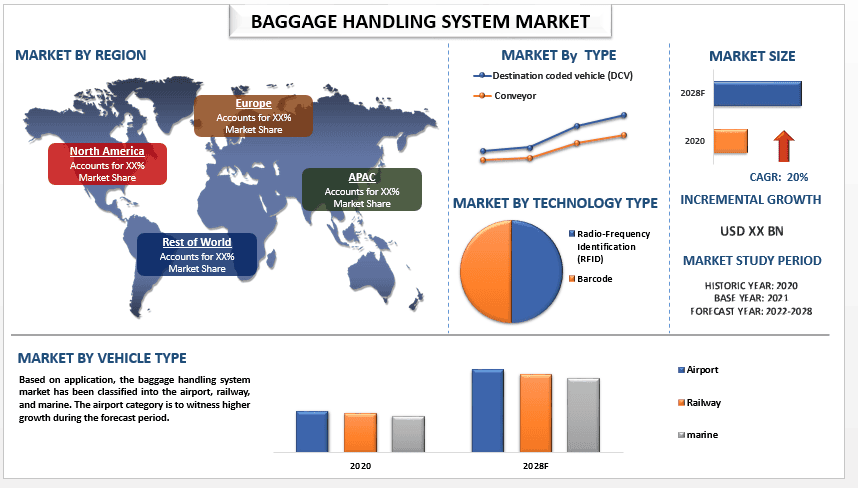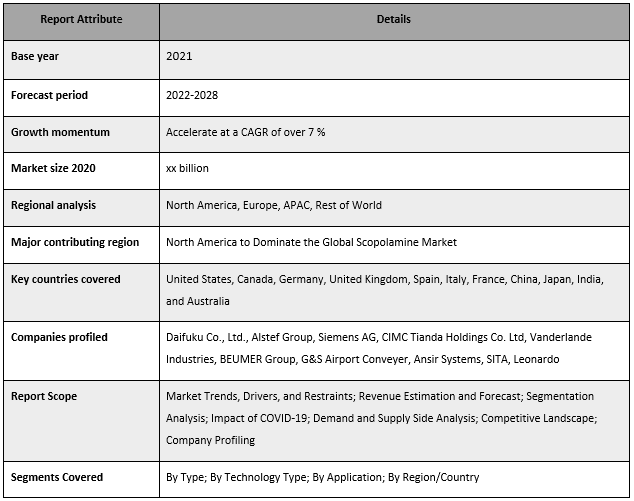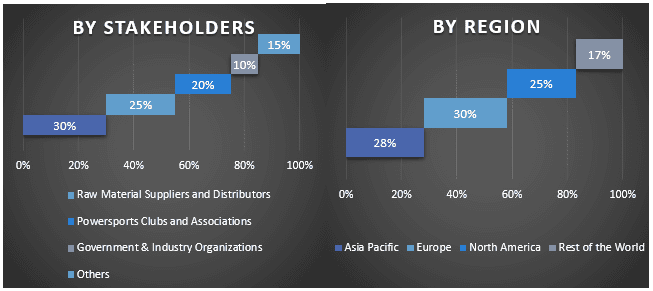- Home
- About Us
- Industry
- Services
- Reading
- Contact Us
Baggage Handling System Market: Current Analysis and Forecast (2022-2028)
Emphasis on Type (Destination coded vehicle (DCV) and Conveyor) Technology Type (Radio-Frequency Identification (RFID) and Barcode); Application (Airport, Railway, and Marine)); and Region/Country

Global Baggage Handling System Market is expected to grow at a significant rate of around 7% during the forecast period 2022-2028. The Baggage Handling System Market is primarily driven by the growing focus on improving airport operational efficiency, rising air passenger numbers, and significant advancements in multimodal transportation. An important global industrial trend is airport refurbishment. To provide passengers with a higher degree of comfort and better baggage management, the majority of airport authorities are investing in airport infrastructure modernization. Additionally, the industry is growing thanks to the application of technologies like radio-frequency identification (RFID) and destination-coded vehicle systems (DCV). However, the high initial and ongoing costs of baggage handling systems (BHS) and the severe repercussions of system failure limit market expansion. Additionally, market development potential are anticipated to be profitable in the years to come due to the use of robotization at airports.
Daifuku Co., Ltd., Alstef Group, Siemens AG, CIMC Tianda Holdings Co. Ltd, Vanderlande Industries, BEUMER Group, G&S Airport Conveyer, Ansir Systems, SITA, Leonardo S.p.A. are some of the key players in the market. Several M&As along with partnerships have been undertaken by these players to facilitate customers with hi-tech and innovative products/technologies.
Insights Presented in the Report
“Amongst technology type, barcode category to hold largest market share ”
Based on type, the market is segmented into utility radio-frequency identification (RFID) and barcode. The barcode category holds the largest market share due to the fact that most airline firms worldwide use barcode technology, and it is anticipated to have the largest market share. Barcodes are inexpensive and easy to use. Few airports, nevertheless, can manage luggage with both RFID and barcode tags (A hybrid solution). In comparison to employing the technologies independently, a hybrid system gives a greater scan rate.
“Amongst application type, the railway to hold a significant share in the market in 2020”
Based on application type, the market is categorized into the airport, railway, and marine. The segment railway to hold a significant share of the market in 2020. The usage of baggage handler systems in the railway is expected to grow dramatically because of the use of conveyor belts for processing passenger bags as they reach the station. Utilizing this equipment helps decrease employee hard lifting, improving the effectiveness of operational processes.
Baggage Handling System Market Report Coverage

“North America to hold a significant share in the market.”
During the forecast period, North America is anticipated to account for a sizable portion of the baggage handling system market. This is explained by the region’s growing population, fast modernization, booming aviation sector, and rising airport traffic. The market for baggage handling systems is expected to develop at a faster rate during the projected period due to technological improvements and advancements made to improve passenger security at airports in the area. North American airports are seeing a surge of investment in new cargo handling and air logistics capacity, with rising freighter traffic, in conjunction with congestion at the main hubs, providing a particular boost for second-tier and cargo-focused airports. But many of the major hub airports are also expanding their facilities after the recent strong performance of cargo has highlighted the potential for logistics investments and the shortcomings of some of these airports’ cargo facilities and infrastructure. For instance, Realterm, the parent of air cargo facility developer Aeroterm, is preparing for more cargo projects. In early May it announced the successful closing of $150 million in capital commitments for its open-ended airport logistics properties fund, which has garnered about $900 million in total equity commitments since its formation in 2015.
Reasons to buy this report:
- The study includes market sizing and forecasting analysis validated by authenticated key industry experts.
- The report presents a quick review of overall industry performance at one glance.
- The report covers an in-depth analysis of prominent industry peers with a primary focus on key business financials, product portfolio, expansion strategies, and recent developments.
- Detailed examination of drivers, restraints, key trends, and opportunities prevailing in the industry.
- The study comprehensively covers the market across different segments.
- Deep dive regional level analysis of the industry.
Customization Options:
The global baggage handling system market can further be customized as per the requirement or any other market segment. Besides this, UMI understands that you may have your own business needs, hence feel free to connect with us to get a report that completely suits your requirements.
Table of Content
Research Methodology for the Baggage Handling System Market Analysis (2022-2028)
Analyzing the historical market, estimating the current market, and forecasting the future market of the global baggage handling system market were the three major steps undertaken to create and analyze the adoption of baggage handling systems in major regions globally. Exhaustive secondary research was conducted to collect the historical market numbers and estimate the current market size. Secondly, to validate these insights, numerous findings and assumptions were taken into consideration. Moreover, exhaustive primary interviews were also conducted, with industry experts across the value chain of the global baggage handling system market. Post assumption and validation of market numbers through primary interviews, we employed a top-down/bottom-up approach to forecasting the complete market size. Thereafter, market breakdown and data triangulation methods were adopted to estimate and analyze the market size of segments and sub-segments of the industry pertains to. Detailed methodology is explained below:
Analysis of Historical Market Size
Step 1: In-Depth Study of Secondary Sources:
Detail secondary study was conducted to obtain the historical market size of the baggage handling system market through company internal sources such as annual reports & financial statements, performance presentations, press releases, etc., and external sources including journals, news & articles, government publications, competitor publications, sector reports, third-party database, and other credible publications.
Step 2: Market Segmentation:
After obtaining the historical market size of the baggage handling system market, we conducted a detailed secondary analysis to gather historical market insights and share for different segments & sub-segments for major regions. Major segments are included in the report as type, technology type, and application. Further country-level analyses were conducted to evaluate the overall adoption of testing models in that region.
Step 3: Factor Analysis:
After acquiring the historical market size of different segments and sub-segments, we conducted a detailed factor analysis to estimate the current market size of the baggage handling system market. Further, we conducted factor analysis using dependent and independent variables such as various type, technology type, and applications of baggage handling system. A thorough analysis was conducted for demand and supply-side scenarios considering top partnerships, mergers and acquisitions, business expansion, and product launches in the baggage handling system market sector across the globe.
Current Market Size Estimate & Forecast
Current Market Sizing: Based on actionable insights from the above 3 steps, we arrived at the current market size, key players in the global baggage handling system market, and market shares of the segments. All the required percentage shares split, and market breakdowns were determined using the above-mentioned secondary approach and were verified through primary interviews.
Estimation & Forecasting: For market estimation and forecast, weights were assigned to different factors including drivers & trends, restraints, and opportunities available for the stakeholders. After analyzing these factors, relevant forecasting techniques i.e., the top-down/bottom-up approach were applied to arrive at the market forecast for 2028 for different segments and sub-segments across the major markets globally. The research methodology adopted to estimate the market size encompasses:
- The industry’s market size, in terms of revenue (USD) and the adoption rate of the baggage handling system market across the major markets domestically
- All percentage shares, splits, and breakdowns of market segments and sub-segments
- Key players in the global baggage handling system market in terms of products offered. Also, the growth strategies adopted by these players to compete in the fast-growing market
Market Size and Share Validation
Primary Research: In-depth interviews were conducted with the Key Opinion Leaders (KOLs) including Top Level Executives (CXO/VPs, Sales Head, Marketing Head, Operational Head, Regional Head, Country Head, etc.) across major regions. Primary research findings were then summarized, and statistical analysis was performed to prove the stated hypothesis. Inputs from primary research were consolidated with secondary findings, hence turning information into actionable insights.
Split of Primary Participants in Different Regions

Market Engineering
The data triangulation technique was employed to complete the overall market estimation and to arrive at precise statistical numbers for each segment and sub-segment of the global baggage handling system market. Data was split into several segments & sub-segments post studying various parameters and trends in the areas of type, technology type, and application in the global baggage handling system market.
The main objective of the Global Baggage Handling System Market Study
The current & future market trends of the global baggage handling system market were pinpointed in the study. Investors can gain strategic insights to base their discretion for investments on the qualitative and quantitative analysis performed in the study. Current and future market trends determined the overall attractiveness of the market at a regional level, providing a platform for the industrial participant to exploit the untapped market to benefit from a first-mover advantage. Other quantitative goals of the studies include:
- Analyze the current and forecast market size of the baggage handling system market in terms of value (USD). Also, analyze the current and forecast market size of different segments and sub-segments
- Segments in the study include areas of type, technology type, and application.
- Define and analysis of the regulatory framework for the baggage handling system
- Analyze the value chain involved with the presence of various intermediaries, along with analyzing customer and competitor behaviors of the industry.
- Analyze the current and forecast market size of the baggage handling system market for the major region.
- Major countries of regions studied in the report include Asia Pacific, Europe, North America, and the Rest of the World.
- Company profiles of the baggage handling system market and the growth strategies adopted by the market players to sustain in the fast-growing market
- Deep dive regional level analysis of the industry
Related Reports
Customers who bought this item also bought










